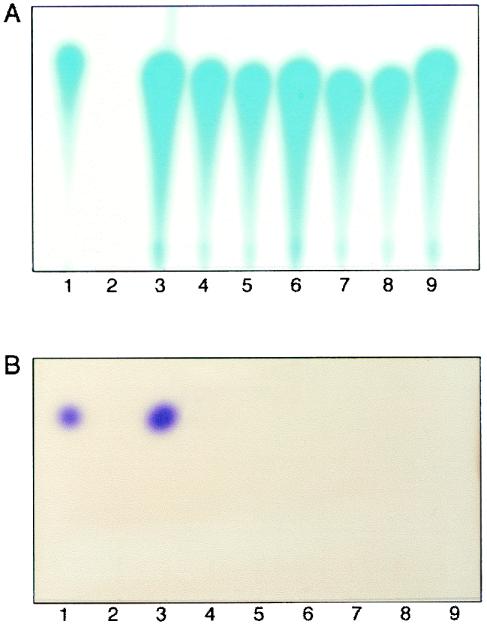FIG. 4.
Quormone retention by cells expressing traR after removal of exogenous acyl-HSL. Cultures of NTL4(pZLQ) and NTL4(pZLQR) were grown to late exponential phase in ABM medium containing IPTG to induce traR and 3-oxo-C8-HSL (panel A) or C6-HSL (panel B). Cells of NTL4(pZLQ) were harvested, washed once with ABM, and lysed, and the cell extracts were assayed for acyl-HSLs (panels A and B, lanes 2) by thin-layer chromatography as described in Materials and Methods. Cells of NTL4(pZLQR) were harvested, and a sample of each culture was assayed for retention of the acyl-HSL after one (panels A and B, lanes 3), two (panels A and B, lanes 4), and four (panels A and B, lanes 5) washes with AB minimal medium. A portion of the six-times-washed cultures of NTL4(pZLQR) originally grown with 3-oxo-C8-HSL and with C6-HSL were diluted into fresh ABM medium lacking quormone and IPTG, and incubation was continued. One-milliliter samples were removed at time zero (lanes 6) and after 4 h (lanes 7), 12 h (lanes 8), and 22 h (lanes 9) of further incubation. Cells in samples taken at each time point were washed and lysed, and ethyl acetate extracts of the lysates were assayed for the acyl-HSLs by thin-layer chromatography with the A. tumefaciens (panel A) or C. violaceum (panel B) reporter strain as described in Materials and Methods. Lane 1 contains samples of pure 3-oxo-C8-HSL (panel A) or C6-HSL (panel B) as standards.

